...; parametric equalizers are not what will permit our speakers in our rooms to sound right.
They won't solve or restore the proper acoustic phases.
What phase? Between the channels? To some extend they do and at low frequencies only impractical amounts of absorption (think non-environment design) will eliminate the detrimental effects the room has on the signal so EQ can improve a situation that can't be improved otherwise.
You just said it. ...Not only acoustic room treatments are required in addition to parametric equalizers, but also microphones (@ various room's positions - listening area) and DSP equalization with FIR and IIR digital filters.
All the room's reflections, reverberations, all the crossovers between the drivers, all the various frequency responses (bass - mid - treble) cannot be fixed by parametric equalizers alone. ...Just too many acoustical delays (phase all over the place). ...Phase of everything; the drivers in the speakers, the electronic x-overs, walls, ceiling, floor, furniture, various materials, the speaker's locations, the subwoofer's locations, the listener's position, the recordings, the source playback machines, the electronic circuit boards inside them machines, the implementation, the wiring, the cables used, the power cords, everything!
We know so very little still about proper sound propagation, reproduction, and propulsion. ...Before we equalize we should know first the acoustic properties.
...And how they are perceived in time and space for a dedicated room's size of a certain composition and correlation with someone's hearing.
And the golden rule of averaging is as good as the ears we accept to use as the ultimate guide. ...But still only a guide, and never absolute.
The standards we create are always to be explored further, and not the scientific audio bible. In sound as in picture we are way behind the reality.
Per the slide show/paper, the systems were: Anthem Statement D2, Audyssey Room EQ, Lyngdorf DPA-1, and two attempts from a Harman prototype using six and then one mic. The top two were Harman, per the blog comments.
Are those parametric equalizers?
That isn't an answer; patience and listening practice do not help measure phase accurately to a small fraction of a degree at high frequency resolution.
Did I not also mention measurement tools, and the pursuit of always improving them?
Plus how they correlate (accurate sound measurements) with our perfect hearing.
Are those parametric equalizers?
The Harman system uses parametric EQ.
Yes you did, but I don't think you actually had any equipment in mind, and I don't know why you're bringing up correlation with hearing again. It was suggested that we should look extremely closely at phase measurements over a few degrees to see that speaker drivers are not minimum phase, I replied asking how we are supposed to take a measurement accurately enough to do that. Simple suggestion, simple question, and based on your two responses, I'm pretty sure you have nothing to say about either. You don't need to reply to every post in this thread, you know.Did I not also mention measurement tools, and the pursuit of always improving them?
Plus how they correlate (accurate sound measurements) with our perfect hearing.
Yes you did, but I don't think you actually had any equipment in mind, and I don't know why you're bringing up correlation with hearing again. It was suggested that we should look extremely closely at phase measurements over a few degrees to see that speaker drivers are not minimum phase, I replied asking how we are supposed to take a measurement accurately enough to do that. Simple suggestion, simple question, and based on your two responses, I'm pretty sure you have nothing to say about either. You don't need to reply to every post in this thread, you know.
1. I will bring whatever I consider important to my ears and mind.
And no I didn't have any specific piece of electronic in mind.
2. It cuts both ways. I reply when I got something to say that I consider worthy of saying.
3. I'm not an audio scientist, I'm not a sound engineer, I'm not an acoustician; I'm just me, a sound explorer in search of answers.
* Watch the Winter Olympics Games; it's relaxing for the soul. 🙂
... It was suggested that we should look extremely closely at phase measurements over a few degrees to see that
speaker drivers are not minimum phase, I replied asking how we are supposed to take a measurement accurately enough to do that. ...
I let Markus, or Mitch, or any other member reading this and interested to give an answer or two, to reply.
I thought, I tried, I suggested, just to advance the discussion by having other members interested in their own reactions, suggestions, ...
The Harman system uses parametric EQ.
Sean Olive's blog said:jj November 6, 2009 at 10:37 PM
So, Sean, tell me, what do you equalize? Time? Midrange Amplitude, first arrival?
Reply
Dr. Sean Olive November 7, 2009 at 12:16 PM
JJ:
All of the above --
Since we know the Harman system uses PEQ to do the Amplitude correction, how do they incorporate the "Time" correction part?
Would it be something like using minimum phase PEQ followed by some sort of phase correction?
For a while I thought about using a linear phase PEQ to correct Amplitude while preserving Time, but would it be a smarter choice to use minimum phase PEQ and correct phase afterwards? The linear phase PEQ might get me in to much trouble with pre-ringing?
Last edited:
^
Minimum phase IS the "time correction part", IF the response is minimum phase to begin with.
Whether a certain frequency range is minimum phase (enough) can be seen in a excess phase group delay graph. See Minimum Phase
Linear phase is probably a bad idea because of filter pre ringing. Mixed phase could be used if pre ringing is kept below audible threshold and if the filter is spatially robust within the listening region. The latter is also true for minimum phase filters.
Minimum phase IS the "time correction part", IF the response is minimum phase to begin with.
Whether a certain frequency range is minimum phase (enough) can be seen in a excess phase group delay graph. See Minimum Phase
Linear phase is probably a bad idea because of filter pre ringing. Mixed phase could be used if pre ringing is kept below audible threshold and if the filter is spatially robust within the listening region. The latter is also true for minimum phase filters.
Last edited:
You guys realize that phase has meaning only if one is using data that contains more than one or two reflections. It's basically random. The difference in MP versus non-MP filtering only has a meaning in the context of anechoic (or gated) based EQ. For steady state based data only MP (IIR) filters make sense.
^
Minimum phase IS the "time correction part", IF the response is minimum phase to begin with.
Whether a certain frequency range is minimum phase (enough) can be seen in a excess phase group delay graph. See Minimum Phase
Linear phase is probably a bad idea because of filter pre ringing. Mixed phase could be used if pre ringing is kept below audible threshold and if the filter is spatially robust within the listening region. The latter is also true for minimum phase filters.
To my ears, linear phase FIR filters sound best for stereo localization. Acourate uses preringing compensation (implemented 3 years ago) to keep preringing below one's audible threshold.
Markus, you have Acourate, why not make minphase and linphase correction filters and compare the two? If using JRiver's Convolver, one can easily AB the correction filters while listening to music, plus compare to PEQ. Report back which one sounds best to your ears.
Some theoretical discussion on this thread, but little discussion on people's actual listening experiences with modern digital room correction software (or PEQ) and filter types...
You guys realize that phase has meaning only if one is using data that contains more than one or two reflections. It's basically random. The difference in MP versus non-MP filtering only has a meaning in the context of anechoic (or gated) based EQ. For steady state based data only MP (IIR) filters make sense.
We're talking about steady state in-room responses. Every response within the listening area represents a linear system. If there are minimum phase regions that are the same for each and every system (look at the excess group delay) then all system responses can be improved with a single filter.
Last edited:
Some theoretical discussion on this thread, but little discussion on people's actual listening experiences with modern digital room correction software (or PEQ) and filter types...
I'm not interested in discussing what sounds good to a random poster on the internet. Listening tests are rather meaningless if biases aren't controlled.
How about some vintage analog gear?
A guy named Paul Kemble recommends SH-9010 - 5-band PEQ from the 70ies by Technics
A Paul Kemble web page - equalisation.
I have two of them and checked them with DEQ RTA function. They appear to work as advertised indeed - reliable and very precise.
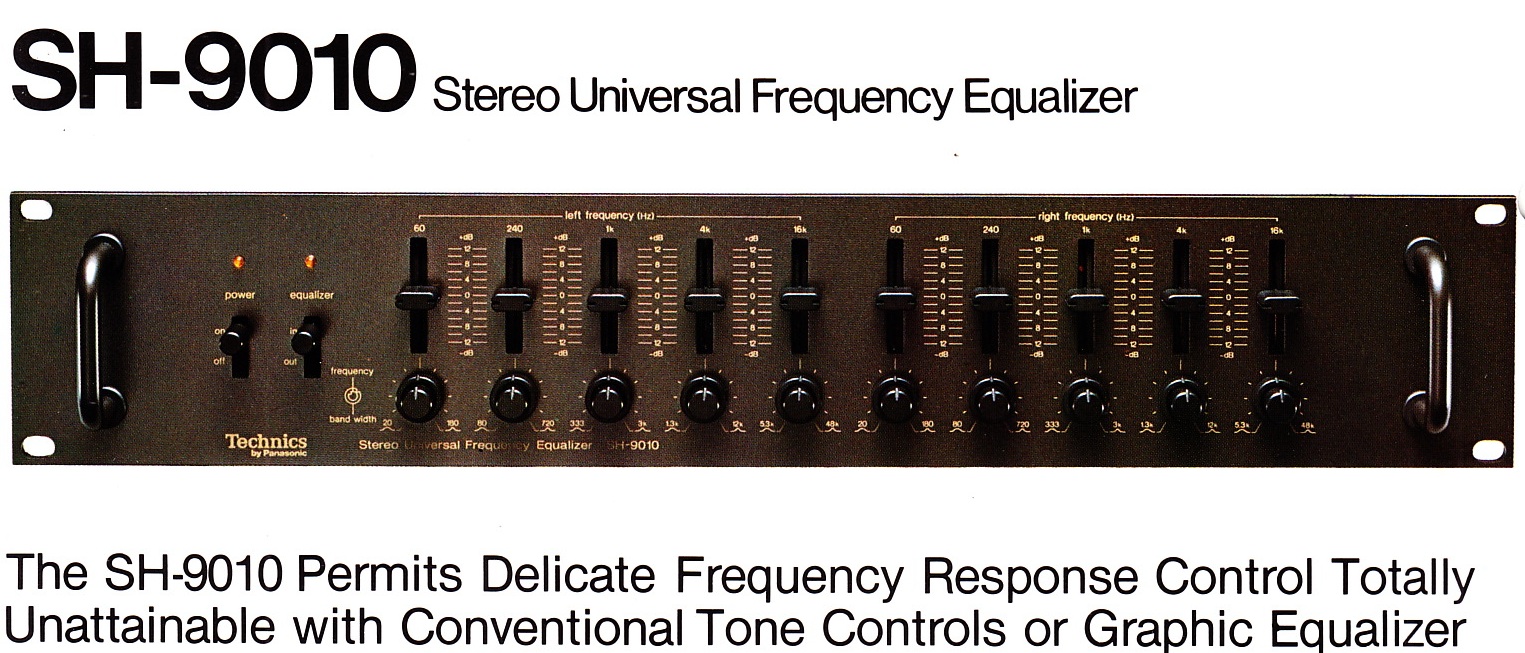
A guy named Paul Kemble recommends SH-9010 - 5-band PEQ from the 70ies by Technics
A Paul Kemble web page - equalisation.
A compact solution that the author favoured for halls, studios and domiciles was the very excellent Technics SH-9010 equaliser, shown below.
I have two of them and checked them with DEQ RTA function. They appear to work as advertised indeed - reliable and very precise.

I'm not interested in discussing what sounds good to a random poster on the internet. Listening tests are rather meaningless if biases aren't controlled.
I have set up several listening tests and reported both measurement and listening results here: http://www.computeraudiophile.com/blogs/mitchco/
Each test is designed to be repeatable so that anyone can set them up and listen for themselves and draw their own conclusions. For example, here is repeatable test to determine how far from bit-perfect one can detect an audible change in SQ playback: Computer Audiophile - Fun With Digital Audio – Bit Perfect Audibility Testing
I'd like to hear everybody's thoughts on the topic. How can PEQs improve reproduction? Can we improve only a single point or even multiple points? What measurements need to be taken? How do we correlate them to what we hear? How to apply PEQs to mixed-phase responses? Etc. pp.
My thoughts, including measurement and listening results are here: Advanced Acourate Digital XO Time Alignment Driver Linearization Walkthrough
If you are not interested in discussing measurement and listening results for room correction, and the correlation thereof, why bother posting your question then?
All the best, Mitch
...For a while I thought about using a linear phase PEQ to correct Amplitude while preserving Time, but would it be a smarter choice to use minimum phase PEQ and correct phase afterwards? The linear phase PEQ might get me in to much trouble with pre-ringing?
...Some theoretical discussion on this thread, but little discussion on people's actual listening experiences with modern digital room correction software (or PEQ) and filter types...
Another experience FYI. My approach has been similar to what wesayso mentioned:
> Use DCX for active XO with delays and filters chosen to achieve phase agreement throughout the XO ranges (SWs-MW and MW-TW).
> Use DCX for PEQ (IIR's) as needed for direct signal EQ and a room mode issues. [Sometimes I also judiciously address a couple of the 100-600 Hz room effects.]
> Use RePhase to design an IR to remove the phase rotation of the direct signal without amplitude impact.
> Use Foobar to provide the convolution.
This method addresses the EQ "needs" and any "wants" without adding any preringing. The phase rotation is also removed without adding any preringing.
Some Charts:
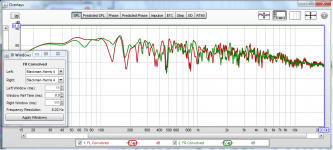
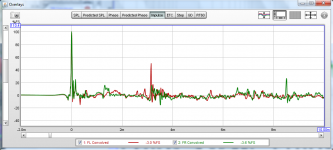
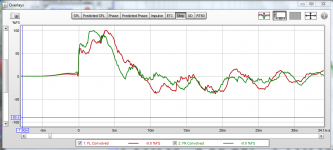
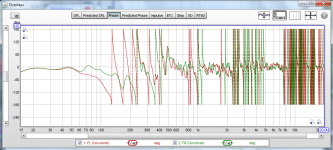
Since my LP is at 4 m I pick up lots of room impact on the phase measurements. The 24" phase of FL and FR is shown below to better show the direct signal phase. When the TW and MR are measured very close (not shown) the phase ripple is nearly completely removed as the impact of the diffraction and reflections is very small.
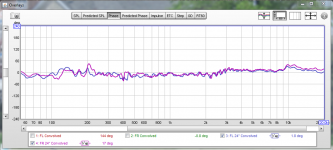
Another experience FYI. My approach has been similar to what wesayso mentioned:
> Use DCX for active XO with delays and filters chosen to achieve phase agreement throughout the XO ranges (SWs-MW and MW-TW).
> Use DCX for PEQ (IIR's) as needed for direct signal EQ and a room mode issues. [Sometimes I also judiciously address a couple of the 100-600 Hz room effects.]
> Use RePhase to design an IR to remove the phase rotation of the direct signal without amplitude impact.
> Use Foobar to provide the convolution.
This method addresses the EQ "needs" and any "wants" without adding any preringing. The phase rotation is also removed without adding any preringing.
jtalden, very nice! Subjectively, I bet your system sounds great ;-)
Neat use of RePhase. Note that using FIR filters the phase can be corrected independently of the amplitude: FIR vs IIR filtering | MiniDSP
Attached is the step response of my system using linear phase FIR filters. Note no preringing.
I will fire up REW and take a measure with the FIR filters in circuit and compare results. In Acourate, looks very similar to what you have in REW, but would be interesting to compare using the same measurement software.
Again kudos, very nice! Thanks for sharing another approach that obviously (to me anyways) works well. Cheers!
Attachments
I'm not interested in discussing what sounds good to a random poster on the internet.
Listening tests are rather meaningless if biases aren't controlled.











jtalden, very nice! Subjectively, I bet your system sounds great ;-)
Neat use of RePhase. Note that using FIR filters the phase can be corrected independently of the amplitude: FIR vs IIR filtering | MiniDSP
Attached is the step response of my system using linear phase FIR filters. Note no preringing.
I will fire up REW and take a measure with the FIR filters in circuit and compare results. In Acourate, looks very similar to what you have in REW, but would be interesting to compare using the same measurement software.
Again kudos, very nice! Thanks for sharing another approach that obviously (to me anyways) works well. Cheers!
I think he meant to say FIR as that is what RePhase will provide (i.m.h.o.)
- Status
- Not open for further replies.
- Home
- General Interest
- Room Acoustics & Mods
- Room Correction with PEQ
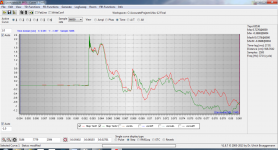
 ...And jtalden for the good post above!
...And jtalden for the good post above!